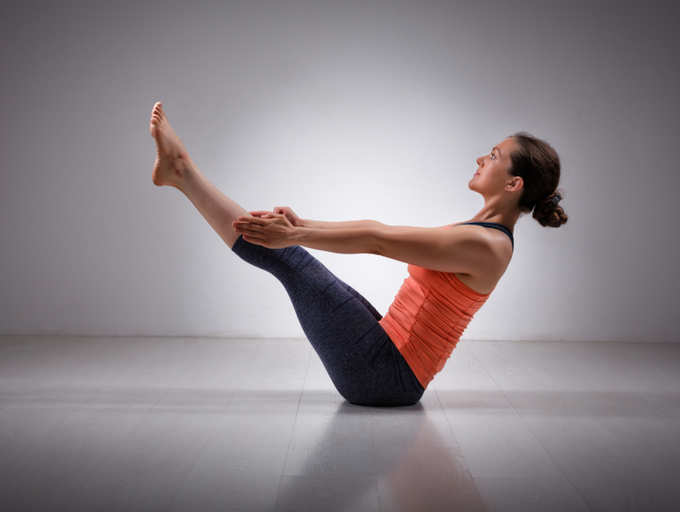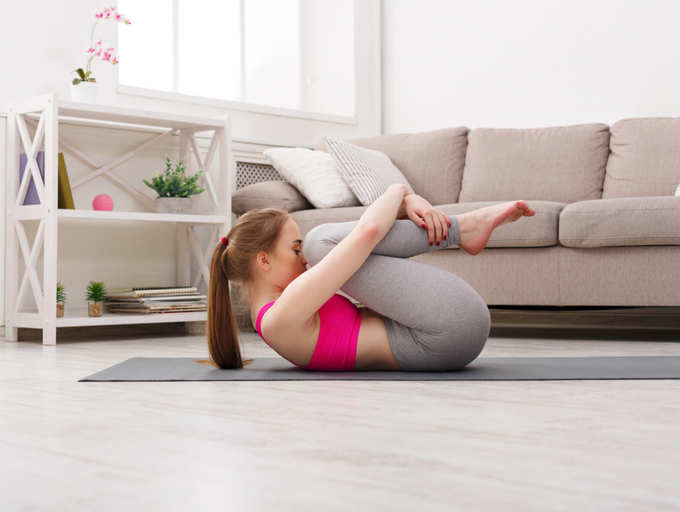A saggy and flabby belly is a major area of concern for most of the people. Unhealthy food choices, poor lifestyle habits and sitting all day long in front of the laptops lead to fat accumulation particularly in the mid-section, making your clothes feel tighter. A bulging belly not only makes you feel conscious about your look but is also unhealthy. This type of fat is referred to as visceral fat, which is linked with type 2 diabetes, heart disease, and other conditions. The most annoying thing about abdominal fat is that it is hard to lose, especially if you do not have enough time to spare in the gym due to your busy schedule. Luckily, even 10 minutes a day can help you come to shape. Here are 10 exercises that work particularly on your abdominal muscles and help to burn all those extra fat from the mid-region. You need to do each of these exercises for 45 seconds, followed by 15 seconds of resting period.
02/11Flutter kicks

Step 1: Lie down on your back with your legs together and hands underneath your buttocks.
Step 2: Lift your right leg off the ground slightly past the hip height. At the same time lift the left leg so it hovers a few inches off the floor. Your back should be on the ground.
Step 3: Hold this position for 5 seconds, then switch the position of the legs, making a flutter kick motion.
Step 4: To make this exercise more challenging, lift your head and neck off the floor.
03/11Kettlebell Swing

Step 1: Stand with your feet shoulder-width apart and hold a kettlebell from the handle with both hands.
Step 2: Bend your knees slightly, push your hips back, and swing the weight between your legs.
Step 3: Stand up, contract your glutes and swing the kettlebell up to about chest height.
Step 4: At the top of the momentum, lock your elbows, keep core tight, and quads and glutes contracted. Return to the squat position and repeat.
04/11Leg raise

Step 1: Lie down on your back with your legs straight and together.
Step 2: Place your hands by your side and keep your legs straight and lift them to the ceiling until your butt comes off the floor.
Step 3: Slowly lower your legs back to the ground.
Step 4: Wait for 2-3 seconds then again take your legs up.
05/11Bhujangasana or Cobra pose

Step 1: Lie on your stomach with your feet wide apart from each other and hands stretched overhead.
Step 2: Join both your legs and rest your forehead on the ground.
Step 3: Pull back your hands underneath your shoulders (palms resting by the side of chest), keeping your elbows close to the body.
Step 4: Take a deep breath and gently lift the upper half of your body.
Step 5: Breathe in and out in this pose for 4-5 seconds and then come back to the starting position.
06/11Leg ins and outs

Step 1: Sit down on the ground with your knees bent and feet placed firmly on the ground.
Step 2: Keep your hand next to your hips. Your entire body weight should be on your butt and hands.
Step 3: Slowly extend your legs out and back in towards your chest.
07/11V-ups

Step 1: Lie on your back and extend your arms behind your head. Feet should be kept together and toes pointed.
Step 2: Keeping your legs straight, lift them up and at the same time raise your upper body off the floor.
Step 3: Keeping your core tight, reach out for your toes.
Step 4: Lower yourself and return back to the original position
08/11Mountain Climbers

Step
1: Get into a high plank position with your hands placed directly under
your shoulder and toes tucked in. Your back should be in a straight
line.
Step 2: Bend your right knee and bring it near your chest, pause and then take it back to its original position.
Step 3: Repeat the same with your left leg. It should look like you are running on your hands and knees.
09/11Russian Twist

Step 1: Sit down on the floor with your knees bent and feet lying flat on the ground.
Step 2: Lean back slightly so your torso and thighs form a V-shape or a 45-degree angle.
Step 3: Clasp both your hands in the front and lift your feet slightly off the ground.
Step 4: Engage your core muscles to twist your torso first to the right, then back to centre, and then to the left.
10/11Side plank with leg lift

Step 1: Lie on your right side and balance your body weight on your right forearm and right leg.
Step 2: Lift your hips in the air to form a straight line from shoulders to ankles.
Step 3: While keeping your torso stable, lift your left leg without bending your knee.
Step 4: Take your left leg up (1 foot) then bring it back to the starting point. Try not to drop your hips.
11/11Reverse Crunches

Step 1: Lie on your back comfortably with your legs stretched and arms resting by your side.
Step 2: Bend your knees and lift them off the floor to bring them to your chest level. This is the starting point.
Step 3: Roll your pelvis upward so that your knees come close to your forehead.
Step 4: Hold the pose and then lower the pelvis back to the starting position, keeping your knees near your chest.
